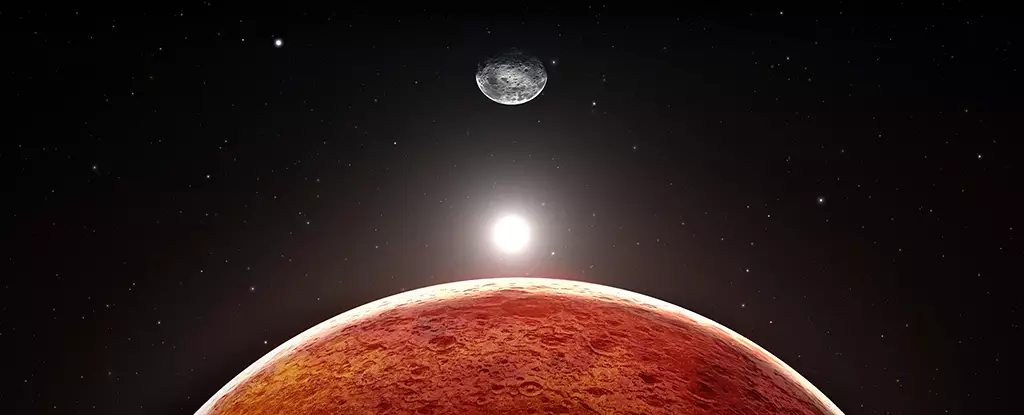Mars, often dubbed the “Red Planet,” has long been a source of fascination for astronomers and scientists alike. Its unusual, distinctly triaxial shape poses a mystery that has eluded experts for decades. This characteristic, where the planet exhibits notable variations in curvature across all three axes, suggests historical geological processes that are not fully understood. A new study proposed by astronomer Michael Efroimsky hints at a captivating potential explanation: the existence of a long-lost moon, possibly named Nerio. This hypothesis not only offers insights into Mars’s anomalous shape but also connects to its geological landscape.
According to Efroimsky’s theory, the potential moon Nerio could have been about one-third the size of Earth’s moon, implying that it would have exerted a considerable gravitational influence on the young Martian landscape. The author argues that before Mars’s shape became fixed, this gravitational interaction could have elongated the planet and influenced the distribution of geological features. Understanding Nerio’s hypothetical existence could explain why Mars has retained a distinctly triaxial appearance unlike any other planet within our Solar System.
The proposed moon is named after an ancient war goddess, which reflects the rich mythology associated with Mars. This connection could signify how ancient cultures recognized the planet’s unique characteristics and attempted to explain them through their belief systems. By naming the moon Nerio, Efroimsky not only opens up a dialogue about Mars’s physicality but also invites us to consider the cultural implications tied to astronomical observations.
Mars’s noticeable triaxiality invites further scrutiny regarding its geological history. Efroimsky suggests that Nerio could have contributed to the initial shaping of the planet’s surface. As the moon rotated in synchronous orbit, maintaining a face-to-face relationship with Mars, it could have helped mold the red planet into the peculiar form we observe today. This process may have created “seed” characteristics that led to a permanent triaxial shape, aligning Mars’s longest axis with the hypothesized moon.
If Nerio indeed existed, its disappearance could have left its mark on Mars’s topography. The planet boasts some of the most striking geological features, including the extensive Tharsis volcanic plateau, the colossal canyon known as Valles Marineris, and the impressive Olympus Mons. These landforms might have been influenced by the cyclical tidal forces exerted by a large moon, inciting volcanic activity and geological upheaval, which could explain their extraordinary scale.
Another critical aspect of Efroimsky’s hypothesis involves the Late Heavy Bombardment period, a time roughly 4 billion years ago when celestial bodies frequently collided with the planets of our Solar System. His theory posits that the destruction of Nerio during this tumultuous time could account for the formation of Mars’s current moons, Phobos and Deimos. These two satellites may very well be the remnants of a once-mighty moon that, following its abrupt demise, fragmented into smaller bodies.
The destructive nature of the Late Heavy Bombardment underscores an idyllic scenario where a massive moon could transform the Martian surface while simultaneously facing obliteration. This interconnected narrative prompts deeper contemplation on how planetary systems evolve under external influences and the cyclical nature of celestial bodies.
While Efroimsky’s proposals present an exciting narrative, they are not without complexities. The absence of tangible evidence supporting a moon like Nerio raises significant questions. Astronomers must consider the lack of identifiable lunar collision signs on Mars that could point to such a monumental event. Nonetheless, the implications of this hypothesis advocate for enhanced exploration and research regarding Mars’s past and the dynamics of its formation.
Future studies could potentially uncover remnants of past celestial interactions, providing stronger support for or against the lost moon theory. Observations from Mars missions and ongoing research into its geological history may eventually yield valuable data to illuminate these mysteries.
The proposition of a lost moon called Nerio introduces a thought-provoking narrative that can potentially reshape our understanding of Mars. The planet’s triaxial characteristics and unique geological features might have deep-rooted connections to its hypothetical lunar counterpart. While the scientific community continues to navigate the complexities surrounding our celestial neighbor, the suggestion that Mars’s unusual shape could be attributed to a long-lost moon is a testament to the ongoing quest for knowledge and understanding of our universe. As we continue to explore Mars, the lines between mythology and planetary science blur, inviting us to reconsider the stories that celestial bodies tell about our cosmic existence.

